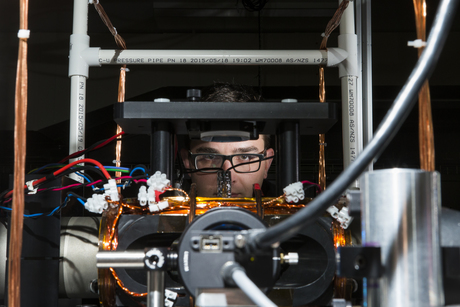Use the Force — scientists halt light in quantum computing experiment

There’s a scene in Star Wars: The Force Awakens where the villainous Kylo Ren uses the mystical power of the Force to stop a laser blast mid-air. Now, physicists from The Australian National University (ANU) have halted light in their own way, bringing the prospect of optical quantum computing one step closer to reality.
Lead researcher Jesse Everett said controlling the movement of light is critical to developing future quantum computers, which could solve problems too complex for today’s most advanced computers. He said quantum computers based on light (photons) could connect easily with communication technology such as optic fibres and have potential applications in fields such as medicine, defence, telecommunications and financial services.
“Optical storage can be achieved via stopped light, where no optical energy continues to exist in the atomic system, or as stationary light, where some optical energy remains present during storage,” Everett and his fellow researchers wrote in the journal Nature Physics.
After Everett discovered the potential to ‘stop’ light in a computer simulation, he and his team decided to replicate it in real life. The result was a ‘light trap’, created by shining infrared lasers into ultracold atomic vapour — and it apparently worked.
“It’s clear that the light is trapped; there are photons circulating around the atoms,” Everett said.
“The atoms absorbed some of the trapped light, but a substantial proportion of the photons were frozen inside the atomic cloud.”
Associate Professor Ben Buchler, who led the ANU research team, said the light-trap experiment demonstrated incredible control of a very complex system. “Our method allows us to manipulate the interaction of light and atoms with great precision,” he said.
Co-researcher Dr Geoff Campbell added that photons mostly pass by each other at the speed of light without any interactions, while atoms interact with each other readily. “Corralling a crowd of photons in a cloud of ultracold atoms creates more opportunities for them to interact,” he said.
With the study results now published in Nature Physics, the researchers are now working towards a single photon changing the phase of a second photon. According to Dr Campbell, “We could use that process to make a quantum logic gate — the building block of a quantum computer.”
Best practices for safe centrifugation in the laboratory
The majority of all centrifuge accidents are understood to result from user error. These tips...
Nature-inspired filtration system recovers critical resources
A filtration system that can recover untapped critical resources such as copper and lithium from...
Optimising food and beverage testing with laboratory equipment
In the food and beverage industry, laboratories must balance precision, speed and compliance to...





